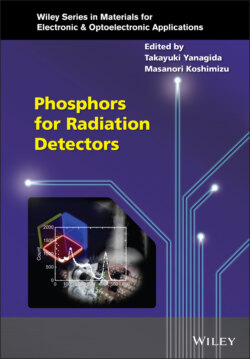Читать книгу Phosphors for Radiation Detectors - Группа авторов - Страница 23
1.4.2 Analytical Description of TSL
ОглавлениеThere are several analysis methods of TSL, and here we introduce a model based on reaction kinetics. The following explanations on TSL analysis can be found in previous literature [79, 80]. In this section, we briefly introduce the common understanding of the analytic formula of TSL, while detailed explanations on practical applications appear in Chapter 7. If we assume E as the threshold of thermal ionization, the probability of thermal ionization is a typical Boltzmann distribution such as
(1.27)
where s, k, and T represent the frequency factor, the Boltzmann constant, and the temperature, respectively. We define n, m, η, and ζ as concentration of free electron, concentration of free hole, proportional constant of radiative recombination, and proportional constant of non‐radiative recombination, respectively. Here, if N is the total number of the electron trapping centers, and n1 is the number of the trapping centers occupied with an electron, then N‐n1 is a number of empty trapping centers. If we define α as a retrapping coefficient, the time dependence of n1 is
(1.28)
We can use the same equation for the trapping center occupied with a hole assuming M as the number of trapping centers for the hole, m1 as the number of trapping centers occupied with the hole, and E' as an activation energy for the hole to the valence band, and the time dependence of the hole center is
(1.29)
where s' is a frequency factor for the hole, γ' is the retrapping coefficient of the free hole, and γm is the recombination coefficient, respectively. We assume J is a constant energy absorption of material (constant), and the number of free electrons and free holes are generated proportional to αJ, where α is a proportional constant. Then, the time dependence of concentrations of electrons and holes are
(1.30)
and
(1.31)
respectively. In these equations, dn1/dt and dm1/dt represent a charging (trapping) process, and (η + ζ)nm and Βm nm1 represent dissipation processes. Let us consider the energy dissipation after stopping the irradiation at temperature T. In this case, if we assume J = 0 in (1.27)–(1.30) at time t = 0, then TL from the electron centers by electron release is
(1.32)
After this time, the time dependence of concentration of electron trapped centers is
(1.33)
If we assume temperature T0 < < E/k and the heating rate of β, the temperature is
(1.34)
The simplest model of luminescence process under this condition is the Randall–Wilkins model. In this classical model, retrapping of electrons is not considered (γ = 0). If we assume (η + ζ) = 0 in Equation (1.30), the TSL intensity can be written as
(1.35)
If we change a variable of Equation (1.33) by Equation (1.34), the temperature dependence of the electron concentration can be expressed as
(1.36)
and after the integration of Equation (1.35) by temperature T, we can obtain
(1.37)
In this equation, n10 means an electron density at T = T0, which equals the concentration of electron trapping centers generated by ionizing radiation exposure. If we combine Equation (1.36) with Equation (1.37), we obtain
(1.38)
Equation (1.38) represents a first‐order kinetics, and if the order is higher than 1, Equation (1.38) changes to
(1.39)
where b is an arbitrary order. Generally, if we can assume E ≫̸ kT and T0 = 0, then
(1.40)
When we combine Equation (1.40) with Equation (1.38),
(1.41)
When we differentiate Equation (1.38) and assume it is equal to 0, it means there is a glow peak in the TSL glow curve. By using the glow peak temperature Tm, we can obtain the relationship
(1.42)
(1.43)
When we combine Equation (1.43) with Equation (1.41), we obtain the relationship
(1.44)
where Δ = 2kT/E. If we combine Equation (1.42) with Equation (1.41), we obtain a maximum TSL intensity of
(1.45)
and the equation of
(1.46)
where Δm = 2kTm/E. If we combine Equation (1.46) with Equation (1.44), we obtain
(1.47)
and
(1.48)
Equation (1.8) is a glow curve deconvolution function (GCD) of first‐order kinetics. In the case of second‐order kinetics (b = 2), Equation (1.39) becomes
(1.49)
When I(T) shows the maximum, we can obtain equations such as
(1.50)
(1.51)
and
(1.52)
If we combine Equation (1.51) with Equation (1.49), the TSL intensity can be expressed as
(1.53)
When the TSL intensity shows the maximum Im, Equation (1.49) can be rewritten as
(1.54)
When we combine Equation (1.52) with Equation (1.54), the maximum intensity can be expressed as
(1.55)
and relationship of
(1.56)
is deduced. Finally, if we combine Equation (1.56) with Equation (1.53), we obtain the equation on the second‐order kinetics of
(1.57)
In addition to these standard analysis, analogical consideration of TSL efficiency with scintillation is considered as
(1.58)
where ηtrap, S′, and ηesc are the trap efficiency of carriers at trapping centers, carrier transfer efficiency to luminescence centers, and a probability that emitted photons are not absorbed in TSL material [81]. Other parameters have the same meaning with scintillation. Some analogical relation is proposed to TSL and OSL [82], and they essentially have the same physical meaning that scintillation and storage luminescence should be treated as one theory.
